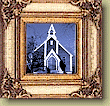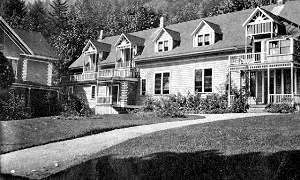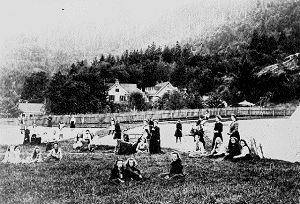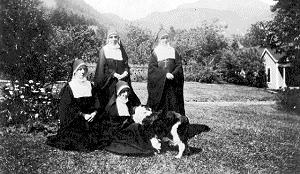
Town Tour
Architectural
Drawings
![]() St. John the Divine
St. John the Divine
![]() On Lee House
On Lee House
![]() Shilson House
Shilson House
in Yale, B.C.
1884 - 1920
by
Lara Kozak
ED-B 423
Instructor: Dr, Alastair Glegg
March 24, 1996
In 1884, a school for First Nations girls was opened by Sisters of the Anglican Church in Yale, British Columbia. This school was eventually called All Hallows School after the original school run by the Sisters in England. All Hallows developed into a boarding school by 1890, taking in both Indian and white girls. The school flourished for twenty-five years under the direction of all of the Sisters who came to work there.
The establishment of All Hallows School in Yale. B.C. came about as a result of similar interests between Anglican missionaries and the federal government. In the late 1800's the federal government wanted Native peoples of Canada to be immediately assimilated into white society. During this same time period, Anglican missionaries were spread all over B.C. marking out 'key' locations to influence Native conversion. The missionaries wanted to convert and "civilize" Native peoples. They thought that it was important to educate the young Native generation into European ways.1
From 1867, Anglican Reverend John Good had worked the stretch of the Cariboo Road between Yale and Lytton. He gave the Anglicans claim to that area stretching north-west to Lillooet, east to Nicola Valley and south along the Fraser River almost to Chilliwack.
In 1879, a new Anglican Bishop, Acton Sillitoe, arrived to this area of British Columbia from England. He became concerned with the welfare First Nations girls on the reserves. He worried because the government had made no provision for the girl’s training. Sillitoe thought that they needed an education to help them cope with the new way of life brought about by the coming of the white man. Sillitoe felt that there was a "great need of higher education and culture,"2 in British Columbia. Bishop Sillitoe returned to England and visited All Hallows School in Ditchingham. He was impressed by the dedication of the Sisters who ran the school, as well as by the high standards of education provided there. Upon his return to B.C., the bishop wrote to the Mother Superior of the English Convent to ask if two or three of the Sisters from Ditchingham could come to B.C. and establish a school for First Nations girls. He was granted immediate consent.
In the autumn of 1884, Sister Amy and Sister Alice arrived in Yale from Ditchingham, England. They must have been shocked as the terrain around Yale was quite unlike that of England. The steep, jagged mountains of the Fraser Canyon were much different from the lush rolling hills of England!
The former gold rush town of Yale had been one of the key locations identified by missionaries to begin the education and conversion of Native people. Yale had been a bustling centre of activity as the base of operations for the construction of a major portion of the transcontinental railroad. But by the Sisters' arrival in 1884, the CPR construction was almost complete through the Fraser Canyon and the community of Yale was gradually declining.
At first, the Sisters opened a day school in the vicarage of the Anglican Church to school a few local First Nations girls. They even took in wash to raise money to support the school.3 The two sisters handled all of the teaching and administrative duties during that first year. After one year of teaching the school was moved to the larger abandoned CPR hospital. As well, academic teachers were hired, leaving the Sisters free to handle administration and religious instruction. As the Sisters' school became known, the number of students increased. The attendance rate was irregular, however, they deemed the necessity of a boarding school, They also needed more money and space.
Bishop Sillitoe had initiated the Columbian College for white girls in New Westminster in the early 1880's. This school collapsed due to lack of funds, Sillitoe proposed that the Sisters take in the girls from the College along with the Native girls. They could use the money that had been promised to Columbian College by an English missionary society. The Sisters agreed to Sillitoe's proposal and plans for the establishment of a boarding school began.
'Brookside’, the former home of railroad contractor Andrew Onderdonk, was purchased and remodelled into classrooms and dormitories. The spacious home and grounds were a perfect setting for a girls schools "not only delightful as to externals but within provided with all things necessary to the health and comfort of the pupil-protegees."4 Even Onderdonk's stable was converted into a chapel! As well, the home of J.W. Trutch, B.C.’s first Lieutenant-Governor, was rented and made into extra dormitories. All of the buildings were redesigned to emulate All Hallows School in Ditchingham.

|
| All Hallow's School. (BC Archives: g-02043) |
In 1890, All Hallows School was officially opened in Yale. It was the only school in Canada to enroll both First Nations and white girls in the same facilities. Upon opening, the school enrolled thirty-five First Nations girls and forty-five white girls ranging in age from six into the late teens. Many of the First Nations girls were recruited by local Anglican clerics. Many of the girls parents were in favour of having their daughters attend the school to "learn white ways."5 Most of the First Nations girls came from the Lytton area, with a few also coming from the Shuswap area, Salmon Arm, Lillooet and Chilliwack.
All Hallows attracted many daughters of Anglican clergymen from across British Columbia, The clergymen liked the school's religiously based instruction and "rightly thought it better to send them to a school like this, in which their duty to God and man is taught from the highest of all motives."6 A final reason for attendance at All Hallows for some of the girls, both whites and Indians, was due to lack of educational alternatives.
All Hallows School became known for its high quality and standards of education Upon a visit in 1887, Archdeacon Charles T. Woods was impressed with the "careful and successful teaching" of the Sisters and the 'intelligent, ready, quick answers" given to him by the girls when he conducted exams.7
Nicolai Schou. a member of the school board in Manchester, England, was equally impressed when he visited All Hallows in the summer of 1890 to report on the school's examinations. He noted that the girls at All Hallows School had a good knowledge of the Scriptures, and the "a.questions ... were as a rule well answered" on the examinations of the senior pupils.8 He was also "struck by the generally intelligent reading of the pupils, who in this respect compare favourably with most of the British Columbian boys of like age.9
Two All Hallows oupils exemplified the high standards of education at the school nation-wide in 1907 and 1908. In 1907, one student placed first in B.C. and sixth in Canada on the McGill University entrance exams. In 1908, another student received the first gold medal awarded in Canada by the Royal Academy of Music.
Music was an important part of life at All Hallows School. A violin orchestra was established which performed all over Canada. Nicolai Schou noted that the girls "sang very sweetly in chorus."10 In 1901, during a visit by the Duke and Duchess of York (our current Queen's grandparents). the girls were described as "singing the school song and waving branches of maple leaves.11

|
| Sisters and pupils at All Hallow's School. (BC Archives: a-03609) |
Other activities that the girls at All Hallows School engaged in included reciting poetry, needlepoint, performing plays in a dramatic group and attending a daily chapel service.
Among the gardens of the school grounds could be found a tennis court, hockey and croquet grounds, and an area near the creek which vas flooded in the winter for skating.
In 1893, some of the pupils of All Hallows organized a society they called the Guild of the Holy Child, in which they aimed to help the Church. The society met from 2:30 to 4:30 on Saturdays to work. The Guild's motto was: "No day without a deed to crown it" and it was a rule that this "deed" must be done in "the most quiet and hidden way."12 In the Guild's first report in 189?, they described some of their major projects from the past two years. On Christmas in 1893, the girls made presents for the children at their Diocesan orphanage. They were "only a few poor presents not very nicely made, but put together with loving hearts and willing hands."13 At Easter in 1894, the girls sold some of their sewing to raise money for a "handsome bar cross"14 which was presented to the altar of the parish church In Yale. They also sent an embroidered linen cloth for the altar in Golden and donated five dollars to the Diocesan fund on that Easter. For the rest of that year, the girls of the Guild worked industriously to raise money, holding two musical entertainments and collecting sums in private. With this money they ordered a "beautiful cabinet organ with a full set of reeds and eleven stops, pedals and knee swell."15 They presented the organ to the Sisters, Mission School Chapel on the eve of the feast of St. Andrew. These are just a select few of the generous deeds done by the girls in the Guild of the Holy Child.
The establishment of the Guild of the Holy Child by girls at All Hallows School displays some of the values they were learning from the Sisters. It seems as though the Sisters who ran All Hallows deserve much credit for their dedication to the education of the young girls in attendance. In his journal, Charles Woods saluted the Sisters "conviction that could not but come home to my own heart, of the love, the trust, the patience of the Sisters; so devoted to their work, so fully answered by love and trust and quiet gentle obedience on the part of the children under their care."16 As well, a former pupil of All Hallows, Vera Bennett, wrote a "short history dedicated to the Sisters and teachers of All Hallows and to the happy lives we led there."17 She mentions fond memories of All Hallows School and shows deep respect for the Sisters, without whom the school would never have been established.

|
| Sisters of All Hallow's School, Yale. (BC Archives: g-02042) |
All Hallows School flourished for twenty-five years. After World War II more and more public high schools were opening all over B.C. and more boarding schools were opening in the larger centres. Attendance at All Hallows dropped and funds were low. In 1920, All Hallows School was closed and the Sisters returned to England.
None of the school's buildings are still standing today. All that remains of All Hallows School in the West is a commemorative plaque in the Church of St. John the Divine. On June 10th, 1960, one hundred and twenty five former students of All Hallows returned to Yale for the dedication of the plaque and two brass altar vases to the memory of Sisters Alice, Althea, Elizabeth Ann, Constance, Mabel, Amy, Agatha, Margaret, Louisa, Eileen and Elizabeth Margaret. The plaque reads:
THIS PLAQUE COMMEMORATES THE WORK AND DEVOTION OF THE SISTERS OF THE COMMUNITY OF ALL HALLOWS, DITCHINGHAM, ENGLAND, WHO CAME TO YALE, B.C., AT THE INVITATION OF THE RIGHT REVEREND A.W. SILLIT0E, FIRST BISHOP OF THE DIOCESE OF NEW WESTMINSTER. THE SISTERS BEGAN PAROCHIAL MISSION WORK AMONG THENDIAN PEOPLE IN 1884; AN INDIAN MISSION SCHOOL IN 1885 AND ALL HALLOWS CANADIAN SCHOOL IN 1890. THE SCHOOLS, LOCATED 3/4 OF A MILE WEST OF THIS CHURCH, WERE CLOSED LATER. THE SISTERS RETURNED TO ENGLAND IN 1920.
All Hallows School was a unique establishment in Canada. one which was successful for many years. My hat's off to the Sisters of the Anglican Church for a job well done!
End Notes
- Jean Barman. "Lost Opportunity, Indian and White Girls at All Hallows School, 1884-1920, " Indian Education in Canada, vol.1 (1986)
- John Pearson. Fur and Gold: Stories, Tales and Legends of B.C. (White Rock: S.K. Press Holdings, INC.)
- Jean Barman, "Lost Opportunity", (1890) p.1.
- Nicolai Schou. Report, p.1
- Jean barman, "Lost Opportunity"
- Nicolai Schou. Report, p.1.
- Charles Woods. Extract from his journal, (July 1887), p.1.
- Nicolai Schou. Report, p.1.
- Nicolai Schou. Report, p.1.
- Nicolai Schou, Report, p.1.
- Vera Bennett, "All Hallows School," Okanagan Historical Society, vol.24, (1960)
- Guild of the holy Child, First Report, (1895), p.3.
- Guild of the holy Child, First Report, (1895), p.2.
- Guild of the holy Child, First Report, (1895), p.3.
- Guild of the holy Child, First Report, (1895), p.3.
- Charles Woods; Extract, p.1
- Vera Bennett, "all Hallows School".
BIBLIOGRAPHY
- Barman. Jean, "Separate and Unequal: Indian and White Girls at All Hallows School. 1884-1920." Indian Education in Canada. v. 1. Vancouver: UBC Press. 1986.
- Barman, Jean. "Lost Opportunity: All Hallows School for Indian and White Girls 1884-1920." B.C. Historical News, v. 2. Spring 1989.
- Bennett. Vera. "All Hallows School." Okanagan Historical Society. v. 24. 1960.
- Pearson, John. Fur and Gold: Stories. Tales and Legends of B.C. White Rock: S.K Press Holdings, Inc.
- Schou, Nicolai. Report on the Examination of the All Hallow Mission School. 1890.
- Woods, Charles T, Extract from his journal, July 1887.
- Guild of the Holy Child. First Report, 1895.
Home | Contents | Tour | People | Collection | Transportation | Just For Kids! | Team
|
Last updated 31 August 1998. This digital collection was produced under contract to the SchoolNet Digital Collections Program, Industry Canada. Produced by Schoolnet Digital Collections Team. |

|